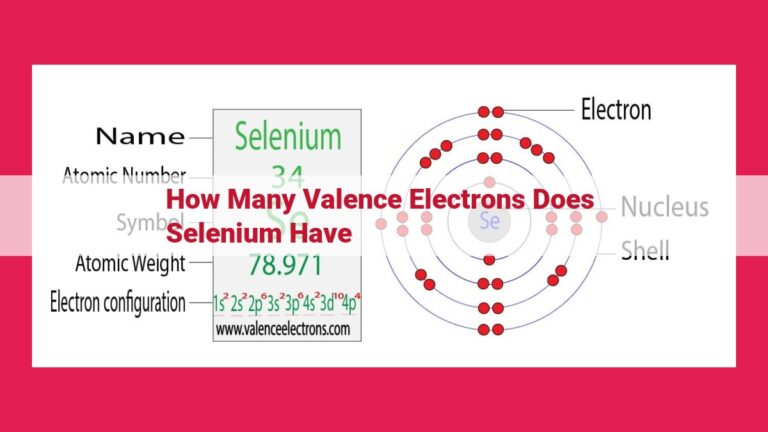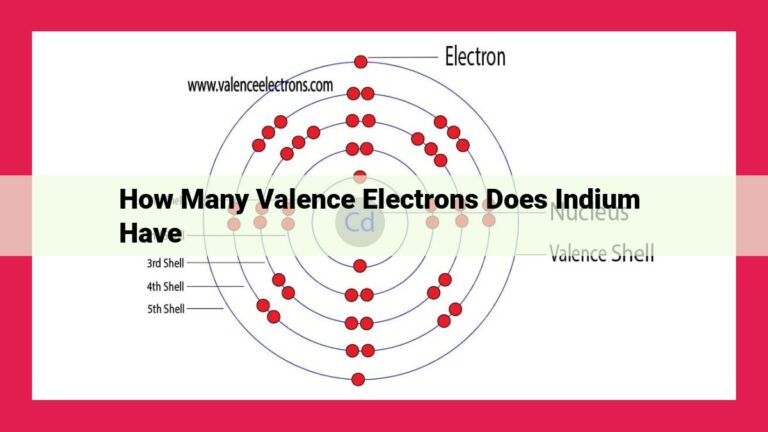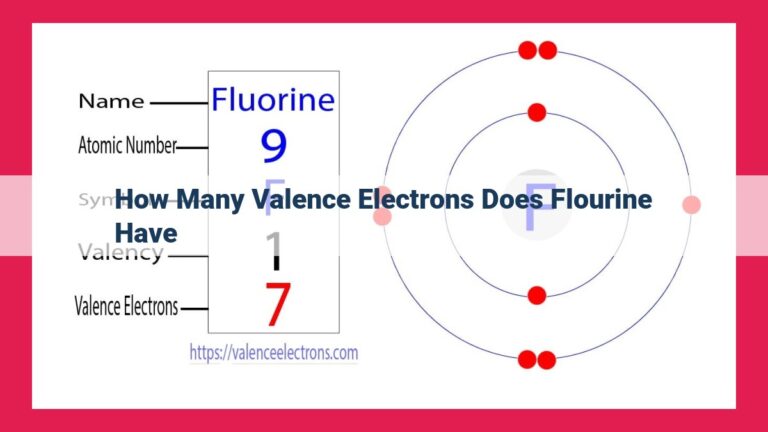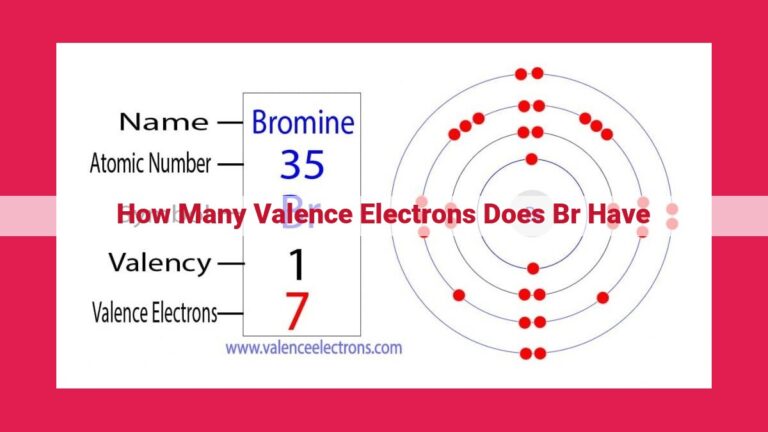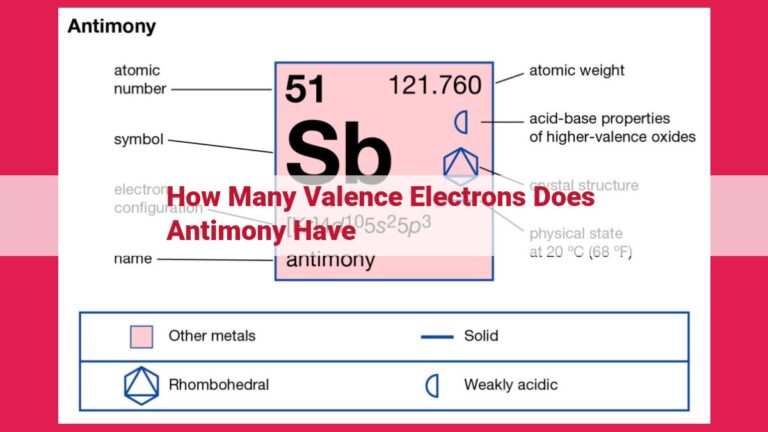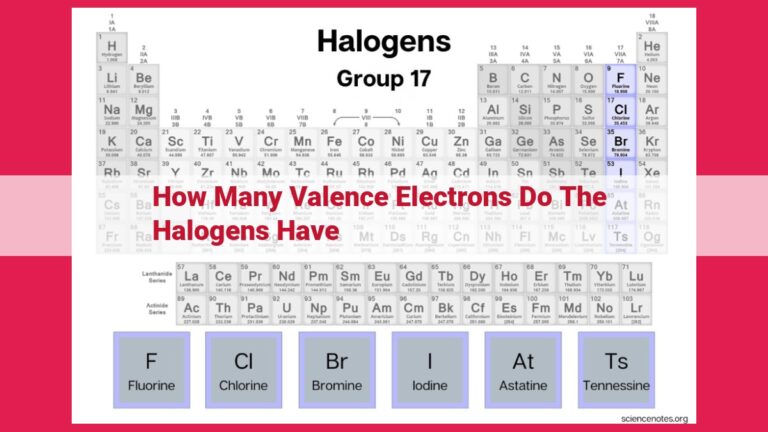Cesium: Unraveling The Electron Configuration Of An Alkali Metal With 6 Electron Shells
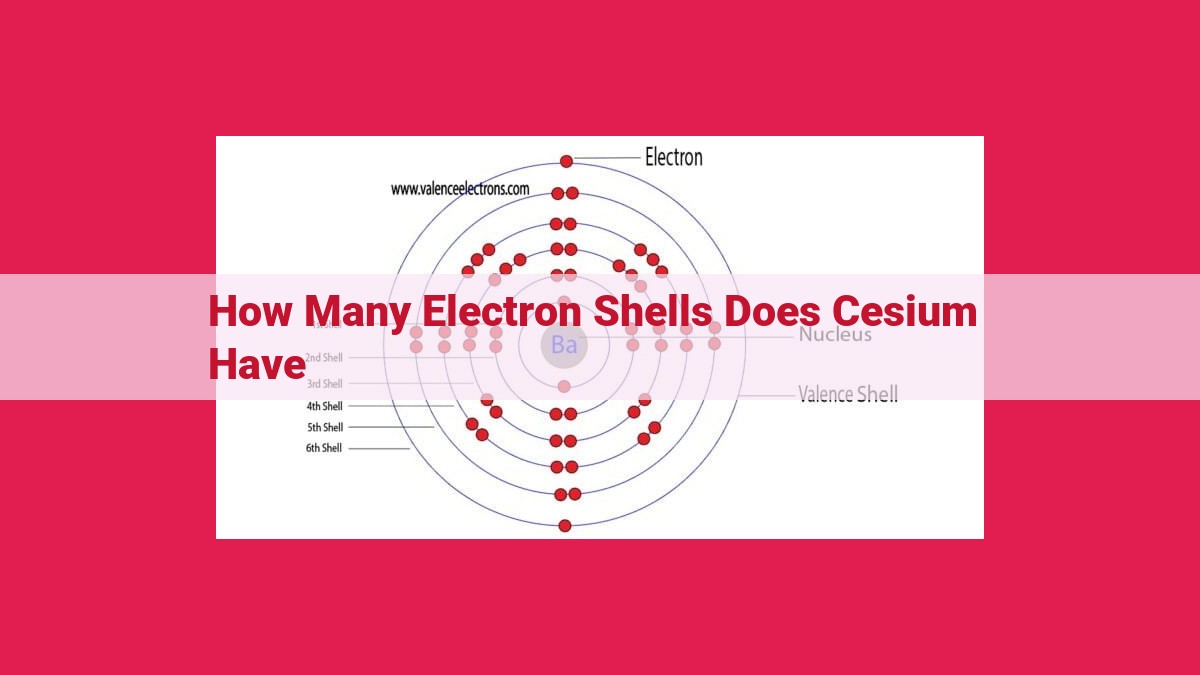
Cesium, an alkali metal located in Group 1 of the periodic table, has an atomic number of 55. Based on the Aufbau principle, its electrons fill orbitals in a specific order, resulting in a unique electron configuration. By counting the number of filled orbitals, which correspond to electron shells, we can determine that cesium has six electron shells.
Unraveling the Mystery: Delving into Atomic Structure and the Secrets of Cesium
In the realm of chemistry, understanding the fundamental principles of atomic structure, electron configuration, and the periodic table is paramount. These concepts lay the foundation for comprehending the behavior and properties of elements, including the fascinating alkali metal, cesium. Our journey today will delve into these principles, ultimately revealing the number of electron shells that define cesium’s atomic makeup.
Atomic Structure: The Building Blocks of Matter
An atom, the building block of all matter, is a miniature cosmos comprised of subatomic particles: electrons, protons, and neutrons. Electrons, negatively charged particles, orbit the atom’s nucleus, while protons and neutrons, found within the nucleus, contribute to the atom’s mass. The organization of electrons within an atom is crucial to its stability and chemical behavior.
Electron Shells: Orbiting Energy Levels
Electrons occupy specific energy levels around the nucleus, known as electron shells. These shells are arranged like a series of concentric rings, with each shell accommodating a fixed number of electrons. The first shell, closest to the nucleus, can hold a maximum of 2 electrons, while subsequent shells can hold 8 electrons each.
Electron Configuration: A Quantum Dance
The distribution of electrons within electron shells is governed by the principles of electron configuration. Quantum numbers, a set of four numbers describing an electron’s energy, shape, and orientation, determine its position within an atom. The Aufbau principle guides the filling of electron shells, stating that electrons occupy the lowest energy levels available. By applying these principles, we can predict the electron configuration of any element.
Periodic Table: A Map of Elements
The periodic table organizes elements based on their atomic number (the number of protons in the nucleus) and electron configuration. Cesium (Cs), an alkali metal, resides in Group 1 of the periodic table, indicating that it has one valence electron—an electron in its outermost shell. This single valence electron is responsible for cesium’s highly reactive properties.
Unraveling Cesium’s Electron Shells
To determine the number of electron shells in cesium, we must first find its atomic number. The periodic table reveals that cesium has an atomic number of 55, signifying that it has 55 protons. According to the Aufbau principle, cesium’s electrons will fill the first five shells, accommodating 2 electrons in the first shell, 8 electrons in the next two shells, and 18 electrons in the fourth and fifth shells. This leaves 1 electron for the sixth and outermost shell. Thus, cesium has six electron shells.
Through this exploration of atomic structure, electron configuration, and the periodic table, we have unveiled the mystery of cesium’s electron shell configuration: six in total. This understanding provides a foundation for further investigations into the behavior and properties of this fascinating element. By unraveling the intricate tapestry of atomic structure, we empower ourselves to comprehend the complexities of the chemical world.
Atomic Structure
- Definition of atomic structure and subatomic particles
- Electron shells and their role in atomic structure
Unlocking the Enigma of Atomic Structure: A Journey to the Heart of Matter
Every atom, the fundamental building block of matter, harbors within it a universe of miniature particles, arranged in an intricate dance under the watchful eye of量子力学. To decipher the mysteries of atomic structure, we embark on an adventure through time and space, unraveling the secrets of subatomic particles and the enigmatic world of electron shells.
At the heart of every atom lies a minuscule nucleus, teeming with positively charged protons and uncharged neutrons. Circling this nucleus are the electrons, tiny particles with a negative charge that orbit their nuclear counterparts in a cloud-like arrangement. These electrons, governed by the principles of quantum mechanics, occupy distinct regions of space around the nucleus called electron shells.
Electron shells are not static rings, but rather dynamic zones where electrons reside, each with its unique energy level. The shells are arranged in concentric layers, with the innermost shell closest to the nucleus and the outermost shell furthest away. As we venture farther from the nucleus, the energy levels of the shells increase, reflecting the strength of the nuclear attraction on the electrons.
The number and arrangement of electron shells play a pivotal role in determining the chemical properties of an element. The outermost electron shell, known as the valence shell, is particularly crucial as it contains the valence electrons, which participate in chemical bonding. The number of valence electrons is a key factor in determining the element’s reactivity and ability to form compounds.
Navigating the Periodic Table: A Map to the Atomic Landscape
In the vast expanse of elements, the periodic table serves as a comprehensive guide. This tabular arrangement of elements meticulously organizes them based on their atomic structure and properties. Cesium (Cs), our subject of interest, occupies a prominent position in Group 1, the alkali metals. This strategic location reveals that cesium has a solitary valence electron in its outermost shell, a characteristic shared by all alkali metals.
Unveiling the Electron Configuration of Cesium
To determine the number of electron shells in cesium, we delve into the concept of electron configuration. Electron configuration describes the arrangement of electrons within the shells of an atom. Using the Aufbau principle, a fundamental rule in quantum mechanics, we can systematically fill the orbitals of cesium’s electron shells.
Starting with the innermost shell, we allocate two electrons. The next shell accommodates eight electrons, followed by the third shell with 18 electrons. The fourth and fifth shells can hold a maximum of 32 electrons each. Finally, the sixth and outermost shell of cesium accommodates the remaining one valence electron.
Counting the Electron Shells: A Journey to the Core
By tallying the filled electron shells, we uncover the answer to our quest: cesium has a total of six electron shells. Each shell, a discrete energy level, accommodates a specific number of electrons, shaping the atom’s chemical behavior and interactions with the world around it.
Our exploration of atomic structure, electron configuration, and the periodic table has illuminated the intricate nature of matter. Cesium, with its six electron shells and its solitary valence electron, exemplifies the profound influence of atomic structure on the properties of elements. Understanding these fundamental concepts empowers us to unravel the mysteries of the atomic realm and appreciate the captivating tapestry of the universe at its most foundational level.
Unveiling the Electron Configuration of Cesium: A Journey into Atomic Structure
In the realm of chemistry, understanding the fundamental principles of atomic structure is paramount. Electron configuration, the arrangement of electrons within electron shells, plays a pivotal role in determining the properties and behavior of elements. In this blog post, we embark on a captivating journey to unravel the electron configuration of cesium, an element renowned for its unique characteristics.
Peering into the Heart of Atoms: Atomic Structure
Atoms, the building blocks of matter, comprise a nucleus, surrounded by a cloud of negatively charged electrons. These electrons occupy specific energy levels called electron shells, each with a distinct shape and capacity. The Aufbau principle guides the filling of these shells, with electrons occupying the lowest energy levels first.
Electron Properties and Quantum Numbers
Electrons possess three fundamental quantum numbers: principal quantum number (n), angular momentum quantum number (l), and magnetic quantum number (ml). These quantum numbers define the energy, shape, and orientation of electron orbitals within shells. For instance, the principal quantum number (n) corresponds to the shell’s energy level.
Navigating the Periodic Table: Cesium’s Place
Cesium, a member of Group 1 (alkali metals) in the periodic table, holds a special place in our exploration. It occupies the sixth period, indicating that its electrons reside in six electron shells.
Valence Electrons: A Bridge Builder
In chemical reactions, valence electrons, those in the outermost shell, play a crucial role. Cesium, with one valence electron, readily forms ionic bonds by donating this electron to achieve a stable octet configuration.
Delving into Cesium’s Electron Configuration
To determine Cesium’s electron configuration, we assign electrons to its shells in accordance with the Aufbau principle. Beginning with the lowest energy level, we sequentially fill each orbital until we have accounted for the atomic number of cesium, 55. This meticulous process reveals that Cesium’s electron configuration is 1s²2s²2p⁶3s²3p⁶3d¹⁰4s²4p⁶4d¹⁰4f¹⁴5s²5p⁶6s¹.
Through this illuminating journey, we have uncovered the fundamental principles of atomic structure, electron configuration, and the periodic table. By applying these concepts to Cesium, we have precisely determined its number of electron shells (six). This knowledge empowers us to comprehend the chemical behavior and properties of elements, paving the way for further scientific exploration and innovation.
Unveiling the Secrets of Cesium: A Journey Through Atomic Structure
In the realm of chemistry, understanding the fundamental building blocks of matter is essential. Atomic structure, electron configuration, and the periodic table act as guiding principles in unraveling the mysteries of elements and their behaviors. Embark on a captivating journey as we delve into the fascinating world of cesium (Cs), a captivating alkali metal with unique properties.
At the heart of every atom lies a nucleus, a tightly bound core of protons and neutrons. Surrounding this central core, like planets orbiting a star, are electrons, negatively charged particles that occupy distinct energy levels or electron shells. These shells, arranged in concentric layers, determine an atom’s electron configuration.
The periodic table, a tabular arrangement of elements, offers valuable insights into electron configuration and atomic properties. Cesium, denoted by the symbol Cs, resides within Group 1, also known as the alkali metals. Alkali metals share a common characteristic: they possess a single electron in their outermost shell, making them highly reactive.
Deciphering Cesium’s Electron Shells
To determine the number of electron shells in cesium, we must consider its atomic number. This number, unique to each element, represents the total number of protons within the nucleus. For cesium, the atomic number is 55, indicating the presence of 55 protons in its nucleus.
Using the Aufbau principle, a fundamental rule in chemistry, we can predict the electron configuration of cesium. According to this principle, electrons fill orbitals in order of increasing energy. Starting from the innermost shell and moving outward, we fill orbitals with electrons until we reach the total number of electrons for the element.
For cesium, with an atomic number of 55, the electron configuration is as follows:
1s² 2s² 2p⁶ 3s² 3p⁶ 4s² 3d¹⁰ 4p⁶ 5s² 4d¹⁰ 5p⁶ 6s¹
Each pair of numbers represents an electron shell, with the first number indicating the shell number and the second number indicating the number of electrons in that shell. Counting the electron shells, we find that cesium has six electron shells.
Through this exploration of atomic structure, electron configuration, and the periodic table, we have uncovered the fundamental characteristics of cesium. With its six electron shells and a single valence electron, cesium exhibits exceptional reactivity and serves as a valuable element in various applications, such as atomic clocks and photoelectric cells. The principles of chemistry provide a profound understanding of the building blocks of our universe, enabling us to unravel the mysteries of matter and its interactions.
Valence Electrons: The Key Players in Chemical Bonding
Imagine if atoms were like tiny magnets, with positive and negative regions. Valence electrons are the electrons that reside in the outermost shell of an atom, and they play a crucial role in determining the atom’s chemical properties. These electrons are the ones that interact with other atoms, forming the bonds that hold molecules together.
The Octet Rule: A Chemical Balancing Act
The octet rule states that atoms tend to gain or lose electrons until they have eight valence electrons. This configuration, known as a “full shell,” provides the atom with the greatest stability. Atoms with fewer than eight valence electrons will tend to form bonds with other atoms in order to achieve a full shell.
For example, let’s look at sodium (Na) and chlorine (Cl). Sodium has one valence electron, while chlorine has seven. To achieve stability, sodium will donate its valence electron to chlorine, forming an ionic bond. This results in both sodium and chlorine having a full shell of eight valence electrons.
Determining the Number of Electron Shells in Cesium
Embarking on a curious journey into the microscopic realm, let’s unravel the secrets of cesium’s atomic structure and pinpoint the number of electron shells it boasts. By delving into the fundamental concepts of atomic structure, electron configuration, and the periodic table, we’ll shed light on this intriguing element.
Atomic Architecture: A Glimpse Inside
Imagine an atom as a miniature cosmos, with its nucleus as the central hub and electrons orbiting it like celestial bodies. These electrons are arranged in concentric shells, each characterized by its energy level. Understanding the distribution of these electrons is crucial for comprehending an atom’s behavior.
Electron Configuration: A Dance of Energy and Arrangement
The electron configuration of an element describes how its electrons occupy these shells. It’s like a dance, with each electron seeking its place based on its energy and orientation, guided by the rules of quantum mechanics. The Aufbau principle provides a roadmap, helping us predict this arrangement by filling the orbitals in order of increasing energy.
Navigating the Periodic Table: A Guide to Elemental Properties
The periodic table is a treasure map of elements, revealing their properties and relationships. It organizes elements based on their atomic number, the number of protons in their nucleus. Cesium (Cs), our element of interest, resides in Group 1, known as the alkali metals.
Electrons on the Front Lines: Valence Electrons
Among the electrons in an atom, the valence electrons are the social butterflies, eagerly participating in chemical reactions and determining an element’s reactivity. The octet rule governs their behavior, guiding them towards stability by striving for a full set of eight electrons in their outermost shell.
Unveiling Cesium’s Electron Shell Count
Now, let’s turn our focus to cesium and determine the number of electron shells it possesses.
-
Atomic Number: Cesium has an atomic number of 55, indicating 55 protons in its nucleus.
-
Filling Electron Orbitals: Using the Aufbau principle, we fill the orbitals in order of increasing energy:
- 1s: 2 electrons
- 2s: 2 electrons
- 2p: 6 electrons
- 3s: 2 electrons
- 3p: 6 electrons
- 4s: 2 electrons
- 4p: 6 electrons
- 5s: 2 electrons
- 5p: 6 electrons
- 6s: 1 electron
- Counting Electron Shells: Each filled orbital corresponds to an electron shell. Counting the filled orbitals, we find that cesium has six electron shells.
Our exploration of atomic structure, electron configuration, and the periodic table has led us to the answer: cesium has six electron shells. This understanding unveils the fundamental characteristics of this element, paving the way for further exploration into its enigmatic realm.
